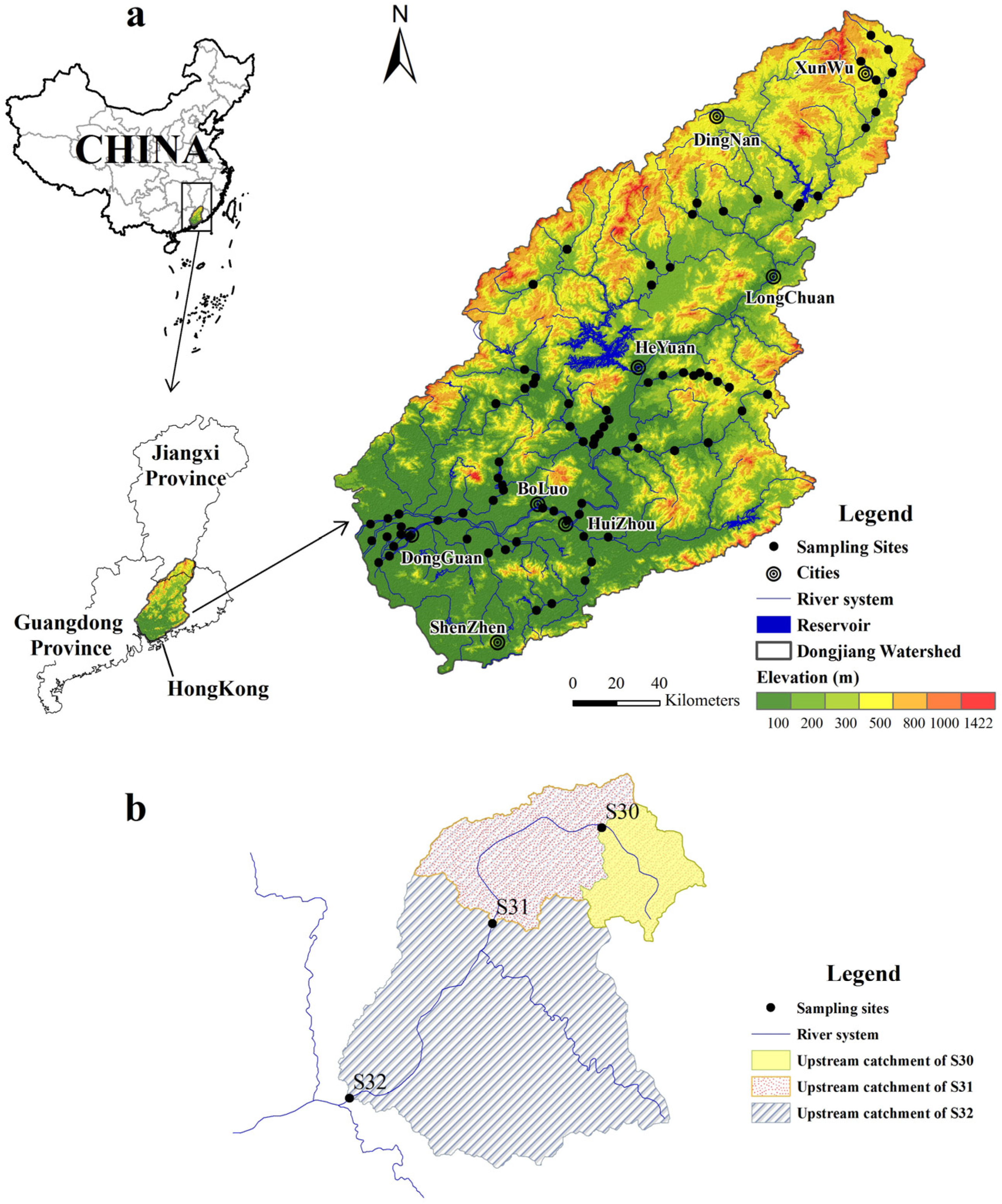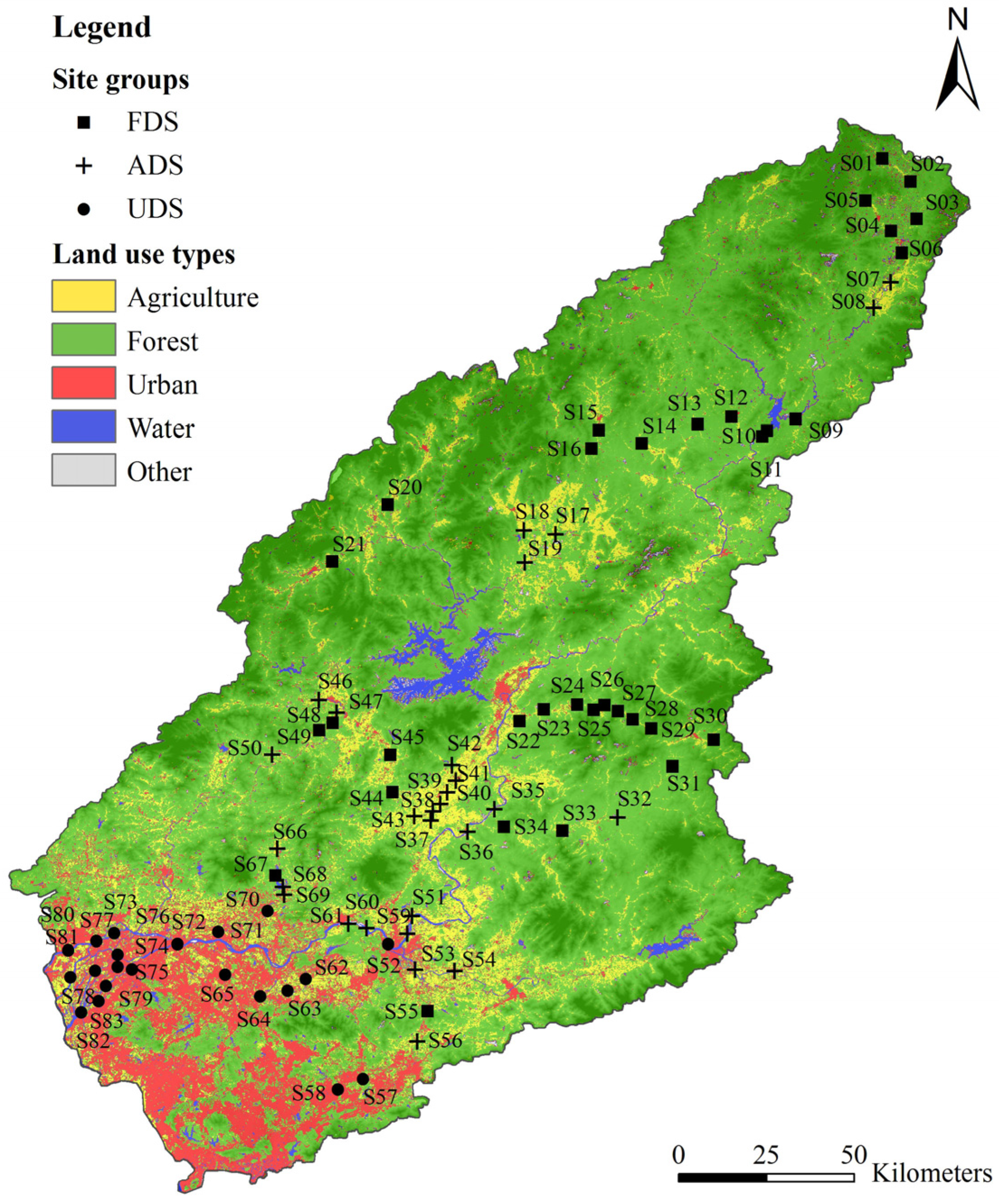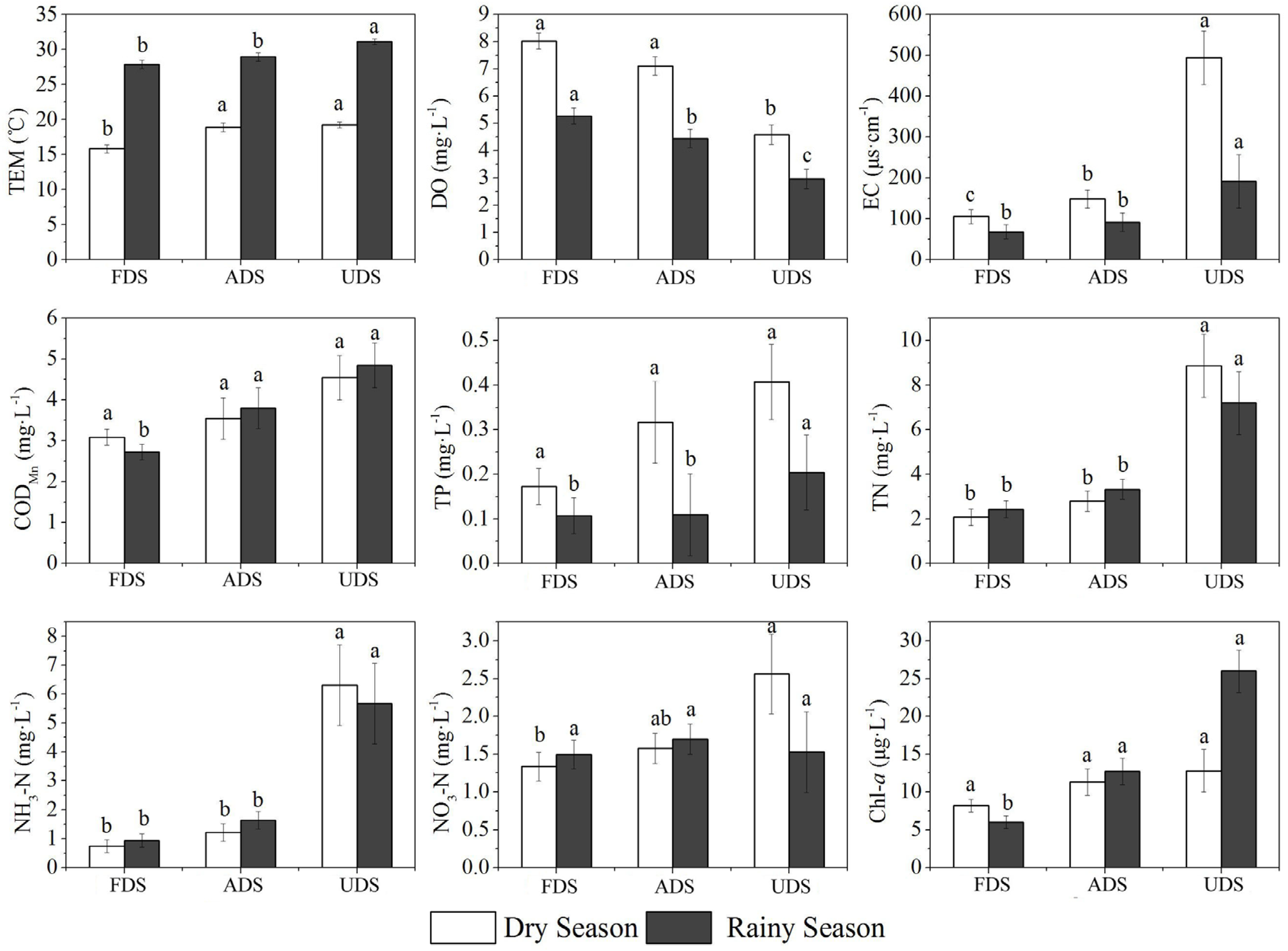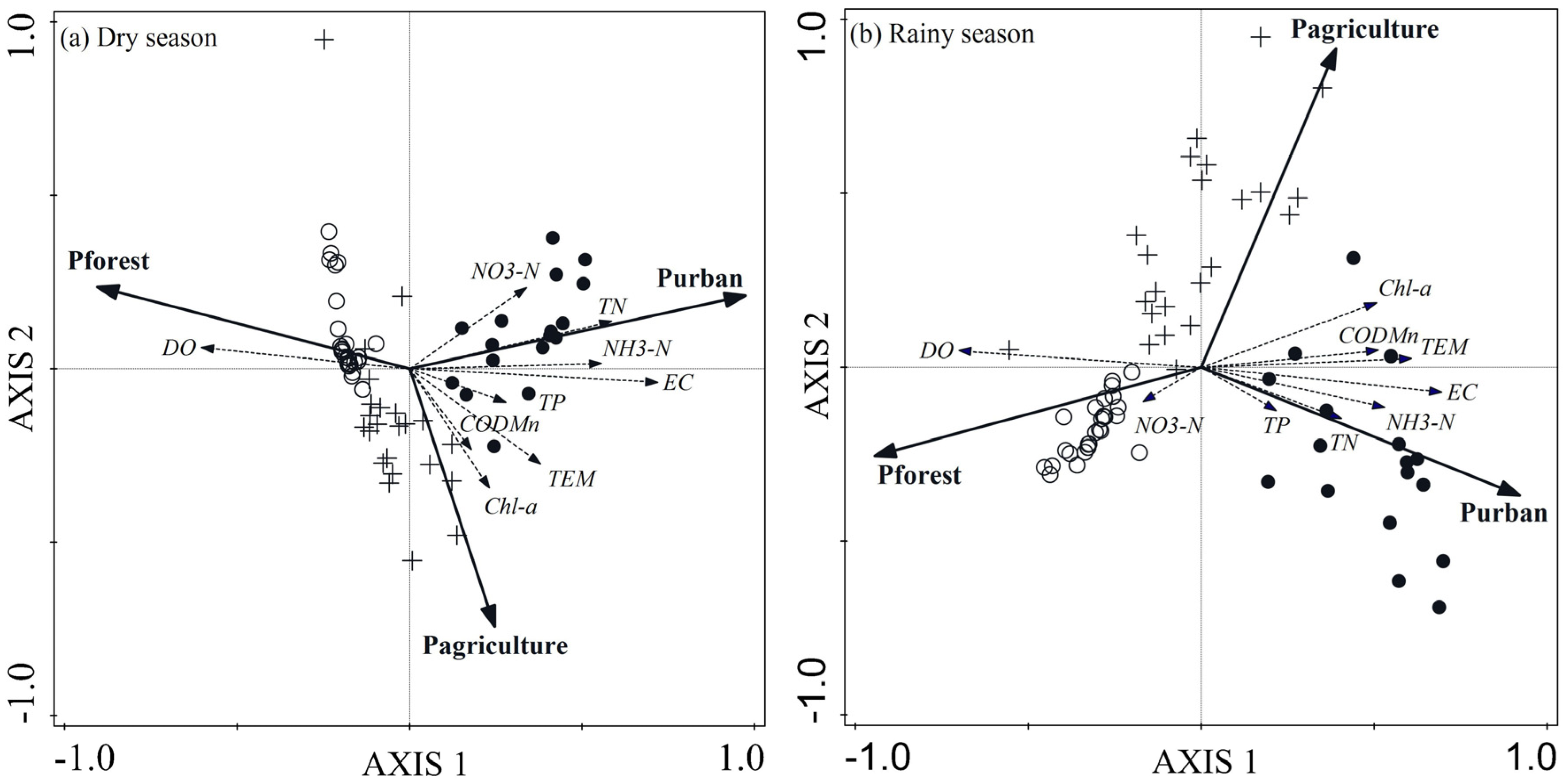Impacts of Land Use on Surface Water Quality in a Subtropical River Basin: A Case Study of the Dongjiang River Basin, Southeastern China
Abstract
:1. Introduction
2. Materials and Methods
2.1. Study Area

2.2. Sample Collection and Parameter Measurement
2.3. Spatial Analyses
2.4. Statistical Analysis
3. Results
3.1. Land Use Site Grouping and Their Distribution
| Spatial scale | Forest (%) | Agriculture (%) | Urban (%) | Other (%) |
|---|---|---|---|---|
| Total watershed | 74.19 | 15.61 | 9.47 | 0.74 |
| Catchments of 83 sites | ||||
| Min | 1.62 | 3.40 | 0.00 | 0.00 |
| Max | 94.93 | 79.49 | 86.62 | 16.25 |
| Mean | 52.59 | 27.48 | 18.92 | 1.01 |
| Median | 56.15 | 24.52 | 3.21 | 0.14 |
| S.D. | 33.28 | 19.74 | 26.46 | 2.16 |
3.2. Temporal and Spatial Variations of Water Quality among the Site Groups

| Landscape Factors | FDS (n = 34) | ADS (n = 28) | UDS (n = 21) |
|---|---|---|---|
| Percentage of Land Use (%) | - | - | |
| Pforest | 86.34 ± 5.86 | 41.87 ± 19.13 | 12.25 ± 13.62 |
| Pagriculture | 11.37 ± 5.10 | 47.76 ± 17.36 | 26.51 ± 11.37 |
| Purban | 1.42 ± 2.15 | 8.60 ± 7.90 | 61.01 ± 15.79 |
| Pother | 0.88 ± 1.44 | 1.77 ± 3.21 | 0.22 ± 0.64 |
| Mainly Land use | forested land | agricultural land | urban land |
| Catchment Elevation (m) | 362 ± 125 | 266 ± 104 | 108 ± 108 |
| Main Topography | hilly mountains | low hills | alluvial plains |

| Water Quality Parameters (Units) | N | Dry Season | Rainy Season | Kruskal-Wallis | Standard for Grade III a | Exceeding Rate (%) b | ||
|---|---|---|---|---|---|---|---|---|
| Mean ± S.D. | Mean ± S.D. | H | p-value | Dry | Rainy | |||
| TEM (°C) | 83 | 17.73 ± 3.41 | 29.07 ± 2.11 | 123.77 | 0.000 ** | - | - | - |
| DO (mg·L−1) | 83 | 6.85 ± 2.19 | 4.41 ± 1.47 | 50.07 | 0.000 ** | ≥5.0 | 20.48 | 55.42 |
| EC (μs·cm−1) | 83 | 218.47 ± 239.04 | 107.59 ± 76.32 | 16.51 | 0.000 ** | - | - | - |
| CODMn (mg·L−1) | 83 | 3.61 ± 2.17 | 3.63 ± 1.70 | 0.38 | 0.538 | ≤6.0 | 16.87 | 14.46 |
| TP (mg·L−1) | 83 | 0.28 ± 0.38 | 0.13 ± 0.13 | 6.54 | 0.011 * | ≤0.2 | 36.14 | 21.69 |
| TN (mg·L−1) | 83 | 4.07 ± 4.70 | 3.95 ± 4.40 | 0.05 | 0.83 | |||
| NH3-N (mg·L−1) | 83 | 2.31 ± 4.13 | 2.37 ± 4.13 | 0.03 | 0.868 | ≤1.0 | 43.37 | 43.37 |
| NO3-N (mg·L−1) | 83 | 1.73 ± 1.60 | 1.57 ± 1.31 | 0.29 | 0.593 | - | - | - |
| Chl-a (μg·L−1) | 83 | 10.42 ± 9.01 | 13.31 ± 15.59 | 0.9 | 0.343 | - | - | - |

3.3. The Relationship between Land Use and Water Quality
| Axes and Variables | Dry Season | Rainy Season | |||||
|---|---|---|---|---|---|---|---|
| Explained Variation (%) | pseudo-F | p value | Explained Variation (%) | pseudo-F | p value | ||
| Canonical axes | |||||||
| First axis | 30.3 | 34.4 | 0.002 ** | 27.5 | 29.9 | 0.002** | |
| Second axis | 2.5 | 2.9 | 0.126 | 1.9 | 2.1 | 0.29 | |
| all axes | 33.2 | 13.1 | 0.002 ** | 29.5 | 11.0 | 0.002** | |
| Explanatory variables | |||||||
| Pforest | 25.0 | 27.0 | 0.002 ** | 24.6 | 26.4 | 0.002** | |
| Purban | 28.9 | 32.9 | 0.002 ** | 23.5 | 24.9 | 0.002** | |
| Pagriculture | 3.4 | 2.8 | 0.078 | 5.8 | 5.0 | 0.01* | |

| Water Quality | Pforest | Pagriculture | Purban | |||
|---|---|---|---|---|---|---|
| Dry Season | Rainy Season | Dry Season | Rainy Season | Dry Season | Rainy Season | |
| DO | 0.57 ** | 0.62 ** | −0.26 * | −0.28 ** | −0.65 ** | −0.61 ** |
| TEM | −0.40 ** | −0.54 ** | 0.42 ** | 0.25 * | 0.43 ** | 0.59 ** |
| EC | −0.71 ** | −0.65 ** | 0.36 ** | 0.28 * | 0.77 ** | 0.66 ** |
| CODMn | −0.16 | −0.48 ** | 0.06 | 0.22 | 0.11 | 0.53 ** |
| TP | −0.32 ** | −0.20 | 0.18 | 0.00 | 0.33 ** | 0.27 * |
| TN | −0.53 ** | −0.35 ** | 0.17 | 0.12 | 0.58 ** | 0.40 ** |
| NH3-N | −0.56 ** | −0.48 ** | 0.26 * | 0.16 | 0.56 ** | 0.53 ** |
| NO3-N | −0.30 ** | 0.23 * | 0.06 | −0.10 | 0.37 ** | −0.17 |
| Chl- a | −0.29 ** | −0.50 ** | 0.25 * | 0.37 ** | 0.31 ** | 0.46 ** |
4. Discussion
4.1. Impacts of Different Land Uses on Water Quality
4.2. Seasonal Differences in Impacts of Land Use on Water Quality
4.3. Management Implication for the Dongjiang River Basin
5. Conclusions for the Restoration of the Dongjiang River
Supplementary Files
Supplementary File 1Acknowledgments
Author Contributions
Conflicts of Interest
References
- Withers, P.J.; Jarvie, H.P. Delivery and cycling of phosphorus in rivers: A review. Sci. Total Environ. 2008, 400, 379–395. [Google Scholar] [CrossRef] [PubMed]
- Vörösmarty, C.J.; McIntyre, P.B.; Gessner, M.O.; Dudgeon, D.; Prusevich, A.; Green, P.; Glidden, S.; Bunn, S.E.; Sullivan, C.A.; Liermann, C.R.; et al. Global threats to human water security and river biodiversity. Nature 2010, 467, 555–561. [Google Scholar] [CrossRef] [PubMed]
- Chen, J.; Lu, J. Effects of Land Use, Topography and socio-economic factors on river water quality in a mountainous watershed with intensive agricultural production in east China. PLoS ONE 2014, 9. [Google Scholar] [CrossRef] [PubMed]
- Kang, J.; Lee, S.W.; Cho, K.H.; Ki, S.J.; Cha, S.M.; Kim, J.H. Linking land-use type and stream water quality using spatial data of fecal indicator bacteria and heavy metals in the Yeongsan river basin. Water Res. 2010, 44, 4143–4157. [Google Scholar] [CrossRef] [PubMed]
- Abler, D.; Shortle, J.; Carmichael, J.; Horan, R. Climate change, agriculture, and water quality in the chesapeake bay region. Clim. Chang. 2002, 55, 339–359. [Google Scholar] [CrossRef]
- Wear, D.N.; Turner, M.G.; Naiman, R.J. Land Cover Along an urban-rural gradient: Implications for water quality. Ecol. Appl. 1998, 8, 619–630. [Google Scholar]
- Amiri, B.J.; Nakane, K. Modeling the linkage between river water quality and landscape metrics in the chugoku district of Japan. Water Resour. Manag. 2009, 23, 931–956. [Google Scholar] [CrossRef]
- White, M.D.; Greer, K.A. The effects of watershed urbanization on the stream hydrology and riparian vegetation of Los Peñasquitos Creek, California. Landsc. Urb. Plan. 2006, 74, 125–138. [Google Scholar] [CrossRef]
- Strayer, D.L.; Beighley, R.E.; Thompson, L.C.; Brooks, S.; Nilsson, C.; Pinay, G.; Naiman, R.J. Effects of land cover on stream ecosystems: Roles of empirical models and scaling issues. Ecosystems 2003, 6, 407–423. [Google Scholar] [CrossRef]
- Tong, S.T.Y.; Chen, W. Modeling the relationship between land use and surface water quality. J. Environ. Manag. 2002, 66, 377–393. [Google Scholar] [CrossRef]
- Lee, S.; Hwang, S.; Lee, S.; Hwang, H.; Sung, H. Landscape ecological approach to the relationships of land use patterns in watersheds to water quality characteristics. Landsc. Urb. Plan. 2009, 92, 80–89. [Google Scholar] [CrossRef]
- Allan, J.D. Landscapes and riverscapes: The influence of land use on stream ecosystems. Ann. Rev. Ecol. Syst. 2004, 35, 257–284. [Google Scholar] [CrossRef]
- Vega, M.; Pardo, R.; Barrado, E.; Debán, L. Assessment of seasonal and polluting effects on the quality of river water by exploratory data analysis. Water Res. 1998, 32, 3581–3592. [Google Scholar] [CrossRef]
- Huang, J.; Li, Q.; Pontius, R.G.; Klemas, V.; Hong, H. Detecting the dynamic linkage between landscape characteristics and water quality in a subtropical coastal watershed, southeast China. Environ. Manag. 2013, 51, 32–44. [Google Scholar] [CrossRef] [PubMed]
- Donohue, I.; McGarrigle, M.L.; Mills, P. Linking catchment characteristics and water chemistry with the ecological status of Irish rivers. Water Res. 2006, 40, 91–98. [Google Scholar] [CrossRef] [PubMed]
- Fisher, D.S.; Steiner, J.L.; Endale, D.M.; Stuedemann, J.A.; Schomberg, H.H.; Franzluebbers, A.J.; Wilkinson, S.R. The relationship of land use practices to surface water quality in the Upper Oconee Watershed of Georgia. For. Ecol. Manag. 2000, 128, 39–48. [Google Scholar] [CrossRef]
- Sliva, L.; Williams, D.D. Buffer zone versus whole catchment approaches to studying land use impact on river water quality. Water Res. 2001, 35, 3462–3472. [Google Scholar] [CrossRef]
- Benes, V.; Pekny, V.; Skorepa, J.; Vrba, J. Impact of diffuse nitrate pollution sources on groundwater quality—Some examples from Czechoslovakia. Environ. Health Perspect. 1989, 83, 5–24. [Google Scholar] [PubMed]
- Lenat, D.R.; Crawford, J.K. Effects of land use on water quality and aquatic biota of three North Carolina Piedmont streams. Hydrobiologia 1994, 294, 185–199. [Google Scholar] [CrossRef]
- Baker, A. Land use and water quality. Hydrol. Process. 2003, 17, 2499–2501. [Google Scholar] [CrossRef]
- Dudgeon, D. Going with the flow: Global warming and the challenge of sustaining river ecosystems in monsoonal Asia. Water Sci. Technol. Water Supply 2007, 7. [Google Scholar] [CrossRef]
- Downing, J.A.; Mcclain, M.; Twilley, R.; Melack, J.M.; Elser, J.; Rabalais, N.N.; Lewis, W.M.; Turner, R.E.; Corredor, J.; Soto, D.; et al. The impact of accelerating land-use change on the N-Cycle of tropical aquatic ecosystems: Current conditions and projected changes. Biogeochemistry 1999, 46, 109–148. [Google Scholar] [CrossRef]
- Gardner, K.K.; McGlynn, B.L. Seasonality in spatial variability and influence of land use/land cover and watershed characteristics on stream water nitrate concentrations in a developing watershed in the Rocky Mountain West. Water Resour. Res. 2009, 45, 1–14. [Google Scholar] [CrossRef]
- Kao, S.; Shiah, F.; Owen, J.S. Export of dissolved inorganic nitrogen in a partially cultivated subtropical mountainous watershed in Taiwan. Water Air Soil Poll. 2004, 156, 211–228. [Google Scholar] [CrossRef]
- Ren, F.; Jiang, Y.; Xiong, X.; Dong, M.; Wang, B. Characteristics of the spatial-temporal differences of land use changes in the dongjiang river basin from 1990 to 2009. Res. Sci. 2011, 33, 143–152. [Google Scholar]
- He, Y.; Lin, K.; Chen, X. Effect of land use and climate change on runoff in the dongjiang basin of south China. Math. Probl. Eng. 2013, 2013, 1–14. [Google Scholar] [CrossRef]
- Ho, K.C.; Hui, K.C. Chemical contamination of the East River (Dongjiang) and its implication on sustainable development in the Pearl River Delta. Environ. Int. 2001, 26, 303–308. [Google Scholar] [CrossRef]
- Zhang, Y.; Dudgeon, D.; Cheng, D.; Thoe, W.; Fok, L.; Wang, Z.; Lee, J.H.W. Impacts of land use and water quality on macroinvertebrate communities in the Pearl River drainage basin, China. Hydrobiologia 2010, 652, 71–88. [Google Scholar] [CrossRef]
- Zhou, T.; Wu, J.; Peng, S. Assessing the effects of landscape pattern on river water quality at multiple scales: A case study of the Dongjiang River watershed, China. Ecol. Indic. 2012, 23, 166–175. [Google Scholar] [CrossRef]
- Liu, D.; Chen, X.; Lian, Y.; Lou, Z. Impacts of climate change and human activities on surface runoff in the Dongjiang River basin of China. Hydrol. Process. 2010, 24, 1487–1495. [Google Scholar] [CrossRef]
- Jiang, Y.; Ding, Z.; Peng, Q.; Liao, J.; Lv, L. Spatial Distribution and Corresponding Factors of Heavy Metals Concentrations in the Dongjiang River Basin, Southeast China. Res. J. Env. Earth Sci. 2012, 4, 448–459. [Google Scholar]
- Wang, M.; Xia, J. Influences of land use changes and climatic vibration on water circulation in the east river valley. Pearl River 2004, 25, 4–6. [Google Scholar]
- Lee, J.H.W.; Wang, Z.Y.; Thoe, W.; Cheng, D.S. Integrated physical and ecological management of the east river. Water Sci. Technol. Water Supply 2007, 7, 81–92. [Google Scholar] [CrossRef]
- Lv, L.; Peng, Q.; Liao, J.; Jiang, Y.; Kang, M. Fluctuation and trends in precipitation and runoff in the Dongjiang river basin over 50 years. Res. Sci. 2013, 35, 514–520. [Google Scholar]
- Fok, L.; Thoe, W.; Koenig, A.; Peart, M.R.; Lee, J.H.W. Nitrogen source apportionment of the east river (Dongjiang), China. Asian Geogr. 2009, 26, 95–110. [Google Scholar] [CrossRef]
- Pearl river water resources commission pearl river bulletins. Available online: http://www.pearlwater.gov.cn/ (accessed on 10 July 2015).
- Grayson, R.B.; Gippel, C.J.; Finlayson, B.L.; Hart, B.T. Catchment-wide impacts on water quality: The use of “snapshot” sampling during stable flow. J. Hydrol. 1997, 199, 121–134. [Google Scholar] [CrossRef]
- National Environmental Protection Bureau. Standard Methods for the Examination of Water and Wastewater (Version 4); China Environmental ScienceChina Environmental Science Publish Press: Beijing, China, 2002.
- Harding, J.S.; Benfield, E.F.; Bolstad, P.V.; Helfman, G.S.; Jones, E.R. Stream biodiversity: The ghost of land use past. Proc. Natl. Acad. Sci. USA 1998, 95, 14843–14847. [Google Scholar] [CrossRef] [PubMed]
- Dodds, W.K.; Oakes, R.M. Headwater Influences on Downstream Water Quality. Environ. Manag. 2008, 41, 367–377. [Google Scholar] [CrossRef] [PubMed]
- Bu, H.; Meng, W.; Zhang, Y.; Wan, J. Relationships between land use patterns and water quality in the Taizi River basin, China. Ecol. Indic. 2014, 41, 187–197. [Google Scholar] [CrossRef]
- Congalton, R.G. A review of assessing the accuracy of classifications of remotely sensed data. Remote Sens. Environ. 1991, 37, 35–46. [Google Scholar] [CrossRef]
- Johnson, L.; Richards, C.; Host, G.; Arthur, J. landscape influences on water chemistry in midwestern stream ecosystems. Freshwater Biol. 1997, 37, 193–208. [Google Scholar] [CrossRef]
- McKenna, J.E. An enhanced cluster analysis program with bootstrap significance testing for ecological community analysis. Environ. Modell. Softw. 2003, 18, 205–220. [Google Scholar] [CrossRef]
- Lu, P.; Mei, K.; Zhang, Y.; Liao, L.; Long, B.; Dahlgren, R.A.; Zhang, M. Spatial and temporal variations of nitrogen pollution in Wen-Rui Tang River watershed, Zhejiang, China. Environ. Monit. Assess. 2011, 180, 501–520. [Google Scholar] [CrossRef] [PubMed]
- Sun, R.; Wang, Z.Z.; Chen, L.; Wang, W. Assessment of surface water quality at large watershed scale: Land-use, anthropogenic, and administrative impacts. J. Am. Water Res. Assoc. 2013, 49, 741–752. [Google Scholar] [CrossRef]
- Pratt, B.; Chang, H. Effects of land cover, topography, and built structure on seasonal water quality at multiple spatial scales. J. Hazard. Mater. 2012, 209, 48–58. [Google Scholar] [CrossRef] [PubMed]
- Hively, W.D.; Hapeman, C.J.; McConnell, L.L.; Fisher, T.R.; Rice, C.P.; McCarty, G.W.; Sadeghi, A.M.; Whitall, D.R.; Downey, P.M.; Nino, D.G.G.; et al. Relating nutrient and herbicide fate with landscape features and characteristics of 15 subwatersheds in the Choptank River watershed. Sci. Total Environ. 2011, 409, 3866–3878. [Google Scholar] [CrossRef] [PubMed]
- Braak, T.C.J.F.; Smilauer, P. Canoco Reference Manual and User’s Guide: Software for Ordination, Version 5.0; Microcomputer Power: Ithaca, NY, USA, 2012. [Google Scholar]
- Shrestha, S.; Kazama, F. Assessment of surface water quality using multivariate statistical techniques: A case study of the Fuji river basin, Japan. Environ. Model. Softw. 2007, 22, 464–475. [Google Scholar] [CrossRef]
- State Environmental Protection Administration. The National Standards of the People’s Republic of China: Environmental Quality Standards for Surface Water (GB 3838–2002); Chinese Environmental Sciences Press: Beijing, China, 2002.
- Liu, Y.; Zheng, B.H.; Fu, Q.; Wang, L.J.; Wang, M. The Selection of Monitoring Indicators for River Water Quality Assessment. Proc. Environ. Sci. 2012, 13, 129–139. [Google Scholar] [CrossRef]
- Nakagawa, Y.; Iwatsubo, G. Water chemistry in a number of mountainous streams of East Asia. J. Hydrol. 2000, 240, 118–130. [Google Scholar] [CrossRef]
- Piatek, K.B.; Christopher, S.F.; Mitchell, M.J. Spatial and temporal dynamics of stream chemistry in a forested watershed. Hydrol. Earth Syst. Sci. 2009, 13, 423–439. [Google Scholar] [CrossRef]
- Paul, M.J.; Meyer, J.L. Streams in the urban landscape. Annu. Rev. Ecol. Syst. 2001, 32, 333–365. [Google Scholar] [CrossRef]
- Dudgeon, D. Endangered ecosystems: A review of the conservation status of tropical Asian rivers. Hydrobiologia 1992, 248, 167–191. [Google Scholar] [CrossRef]
- Waters, E.R.; Morse, J.L.; Bettez, N.D.; Groffman, P.M. Differential carbon and nitrogen controls of denitrification in riparian zones and streams along an urban to exurban gradient. J. Environ. Qual. 2014, 43, 955–963. [Google Scholar] [CrossRef] [PubMed]
- Sun, R.; Chen, L.; Chen, W.; Ji, Y. Effect of Land-Use Patterns on Total Nitrogen Concentration in the Upstream Regions of the Haihe River Basin, China. Environ. Manag. 2013, 51, 45–58. [Google Scholar] [CrossRef] [PubMed]
- Petry, J.; Soulsby, C.; Malcolm, I.A.; Youngson, A.E. Hydrological controls on nutrient concentrations and fluxes in agricultural catchments. Sci. Total Environ. 2002, 294, 95–110. [Google Scholar] [CrossRef]
- Yates, A.G.; Brua, R.B.; Corriveau, J.; Culp, J.M.; Chambers, P.A. seasonality driven variation in spatial relationships between agricutural land use and in-stream nutrient concentrations. River Res. Appl. 2014, 30, 476–493. [Google Scholar] [CrossRef]
- Mouri, G.; Takizawa, S.; Oki, T. Spatial and temporal variation in nutrient parameters in stream water in a rural-urban catchment, Shikoku, Japan: Effects of land cover and human impact. J. Environ. Manag. 2011, 92, 1837–1848. [Google Scholar] [CrossRef] [PubMed]
- Woli, K.P.; Nagumo, T.; Kuramochi, K.; Hatano, R. Evaluating river water quality through land use analysis and N budget approaches in livestock farming areas. Sci. Total Environ. 2004, 329, 61–74. [Google Scholar] [CrossRef] [PubMed]
- Buck, O.; Niyogi, D.K.; Townsend, C.R. Scale-dependence of land use effects on water quality of streams in agricultural catchments. Environ. Pollut. 2004, 130, 287–299. [Google Scholar] [CrossRef] [PubMed]
- Lowrance, R.; Altier, L.S.; Newbold, J.D.; Schnabel, R.R.; Groffman, P.M.; Denver, J.M.; Correll, D.L.; Gilliam, J.W.; Robinson, J.L.; Brinsfield, R.B.; et al. Water Quality Functions of Riparian Forest Buffers in Chesapeake Bay Watersheds. Environ. Manag. 1997, 21, 687–712. [Google Scholar] [CrossRef]
- Chen, J.; Heinke, G.W.; Zhou, M.J. The pearl river estuary pollution project. Cont. Shelf Res. 2004, 24, 1739–1744. [Google Scholar] [CrossRef]
© 2015 by the authors; licensee MDPI, Basel, Switzerland. This article is an open access article distributed under the terms and conditions of the Creative Commons Attribution license (http://creativecommons.org/licenses/by/4.0/).
Share and Cite
Ding, J.; Jiang, Y.; Fu, L.; Liu, Q.; Peng, Q.; Kang, M. Impacts of Land Use on Surface Water Quality in a Subtropical River Basin: A Case Study of the Dongjiang River Basin, Southeastern China. Water 2015, 7, 4427-4445. https://doi.org/10.3390/w7084427
Ding J, Jiang Y, Fu L, Liu Q, Peng Q, Kang M. Impacts of Land Use on Surface Water Quality in a Subtropical River Basin: A Case Study of the Dongjiang River Basin, Southeastern China. Water. 2015; 7(8):4427-4445. https://doi.org/10.3390/w7084427
Chicago/Turabian StyleDing, Jiao, Yuan Jiang, Lan Fu, Qi Liu, Qiuzhi Peng, and Muyi Kang. 2015. "Impacts of Land Use on Surface Water Quality in a Subtropical River Basin: A Case Study of the Dongjiang River Basin, Southeastern China" Water 7, no. 8: 4427-4445. https://doi.org/10.3390/w7084427
APA StyleDing, J., Jiang, Y., Fu, L., Liu, Q., Peng, Q., & Kang, M. (2015). Impacts of Land Use on Surface Water Quality in a Subtropical River Basin: A Case Study of the Dongjiang River Basin, Southeastern China. Water, 7(8), 4427-4445. https://doi.org/10.3390/w7084427





